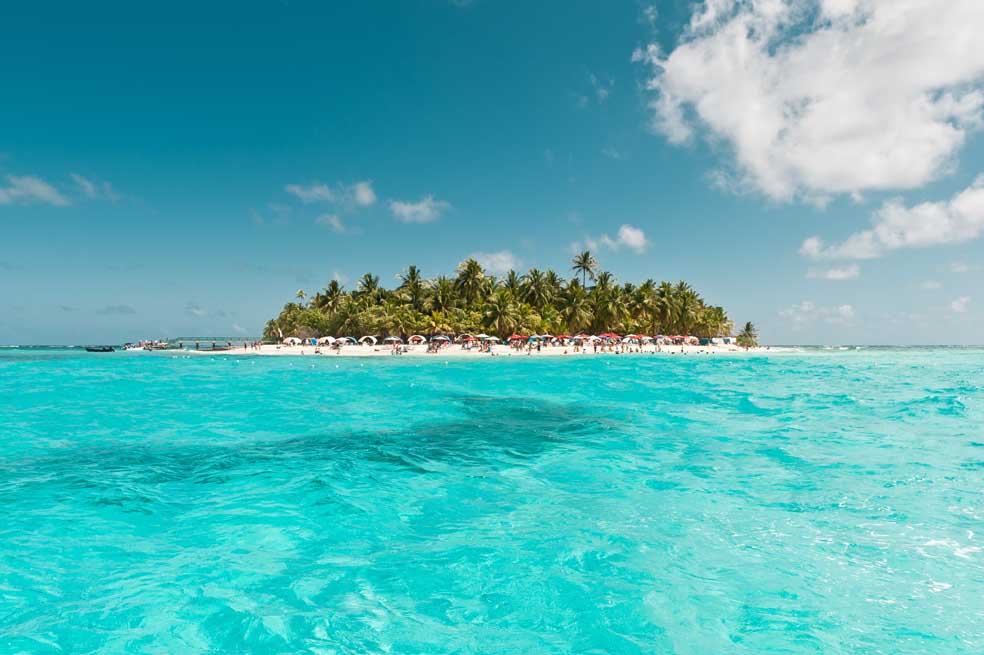
Colombia has an undeniable allure as a travel destination offering a rich tapestry of landscapes that stretch from the Andes to the Amazon, and from bustling cities to pristine coastlines. While many are drawn to Colombia’s cultural heritage and the lush beauty of its mountains and rainforests, its coastal regions remain an untouched haven for marine biodiversity.
Colombia’s extensive coastline, bathed by both the Caribbean Sea and the Pacific Ocean, is a hotbed of marine life. Divers and conservationists are increasingly focusing on these tropical waters, discovering a thriving ecosystem with an incredible variety of species. In this article, we will delve into the vibrant world of marine biodiversity along Colombia’s coasts, exploring what makes these waters remarkable and why they deserve our attention and protection.
Caribbean Coast: A Cornucopia of Coral Reefs
Colombia’s Caribbean coast, particularly the area around the Rosario and San Bernardo Islands National Park, hosts some of the most impressive coral reefs globally. This region is an essential part of the Mesoamerican Barrier Reef System, the second-largest coral reef system in the world and a UNESCO World Heritage site.
Here, you’ll encounter an astonishing variety of coral species, from massive brain corals to delicate sea fans, creating a colorful underwater city. Among these corals live an astounding assortment of marine creatures. Dazzling parrotfish, angelfish, and butterflyfish flit among the corals. Turtles, including loggerheads and hawksbills, find refuge in these waters. Octopuses, rays, and even nurse sharks glide gracefully through the coral gardens. Vibrant sponges, crustaceans, and seahorses add to the kaleidoscope of life. Colombia’s Caribbean coast is a paradise for both beginner and experienced divers and snorkelers.
Pacific Coast: Where the Jungle Meets the Ocean
On the Pacific side, Colombia’s coasts offer a distinct contrast. Here, the lush Amazon rainforest meets the ocean, creating a unique and diverse ecosystem. The mingling of freshwater and saltwater results in an explosion of life, making this region one of the most biodiverse on the planet.
The waters near Nuqui and Bahia Solano are teeming with marine biodiversity. However, diving here can be challenging, as you navigate around rocks and sunken boulders. Your reward is the opportunity to witness a wide range of aquatic life, from massive groupers and horse mackerel to rays and elusive devil fish. It’s not uncommon to spot octopuses, lobsters, and various types of eels hiding among the crevices. For experienced divers, the Pacific coast of Colombia is a treasure trove of marine wonders.
San Andres and Providencia: Pristine Reefs and Hidden Shipwrecks
Moving back to the Caribbean Sea, off the coast of San Andres and Providencia, divers will discover another aquatic wonderland. The island of Providencia is home to the third-largest barrier reef in the world, with over 40 dive sites.

Divers in this area are treated not only to the beauty of coral gardens and marine life but also to intriguing encounters with historical shipwrecks. Pirates once roamed these waters, and remnants of their vessels remain on the ocean floor. The combination of thriving marine ecosystems and the allure of sunken ships makes diving around San Andrés and Providencia a unique experience.
Taganga, Santa Marta: A Diver’s Training Ground
For those looking to start their diving journey, Taganga near Santa Marta is an ideal destination. Numerous diving operators in this area offer courses that are both affordable and accessible. While learning the ropes, you can explore an array of colorful corals and interact with various species that call these waters home.

Taganga’s convenient location, coupled with its rich biodiversity, makes it a popular choice for beginners. As you develop your diving skills, you can gradually venture into more challenging sites along the Colombian coast.
Malpelo: A Haven for Experienced Divers
For experienced divers seeking an adrenaline rush, Malpelo Island is an exciting challenge. Situated far from the mainland, this remote, rocky formation presents an array of strong currents and complex underwater landscapes. You’ll need skill and training to dive in these waters.

However, the effort is rewarded with a breathtaking diversity of marine life. Hammerhead sharks, silky sharks, and the elusive smalltooth sand tiger sharks are common sightings. Schools of jacks, huge tunas, and even bottlenose dolphins often make appearances. If you’re up for an adventure and have the diving experience to match, Malpelo is a destination like no other.
Conservation and Ecotourism
While Colombia’s coasts are indeed a treasure trove of marine biodiversity, they are also vulnerable to the threats that affect oceans worldwide. Overfishing, pollution, and climate change pose significant risks to these ecosystems. Thankfully, conservation efforts are gaining momentum. Organizations, divers, and local communities are working together to protect and preserve the marine wonders of Colombia.
See all the latest news from Colombia and the world at ColombiaOne.com. Contact our newsroom to report an update or send your story, photos and videos. Follow Colombia One on Google News, Facebook, Instagram, TikTok and subscribe here to our newsletter.


